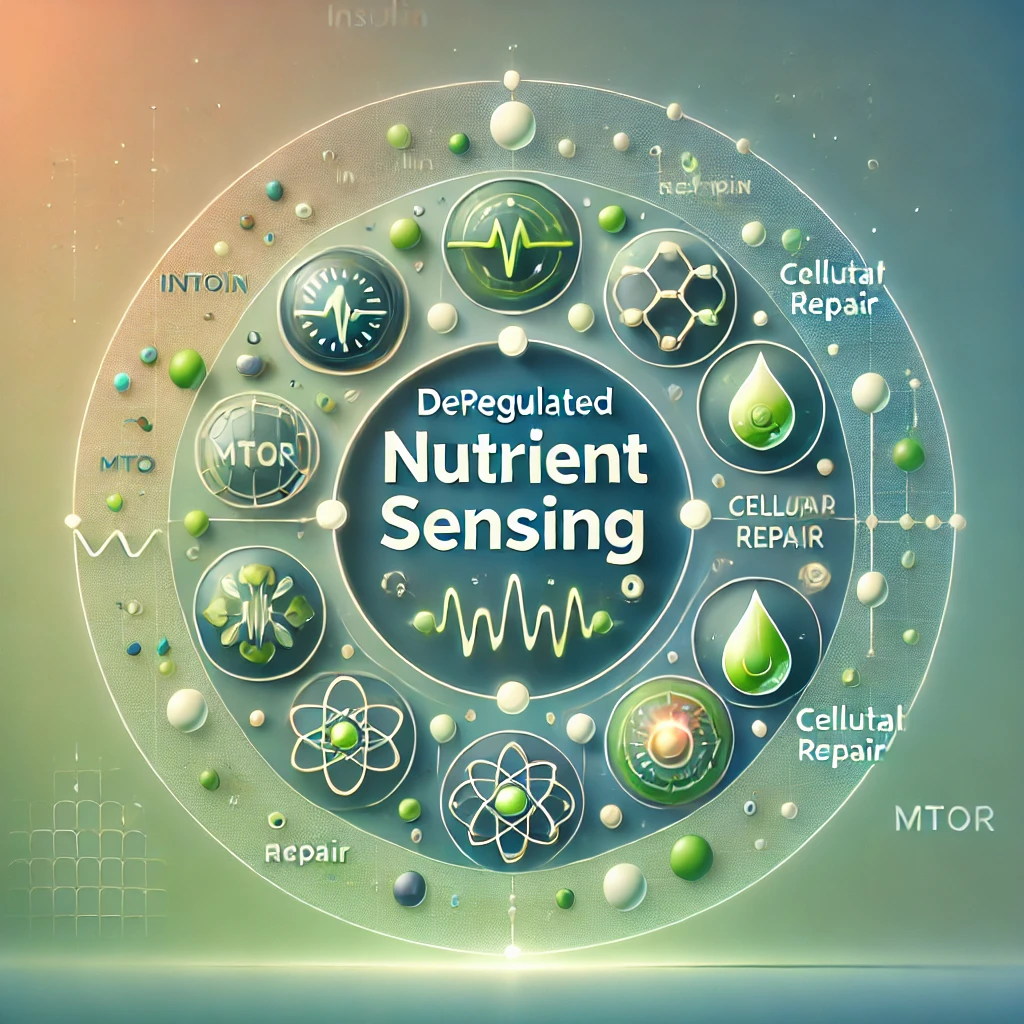1. Deregulated Nutrient Sensing
Description
- Deregulated nutrient sensing refers to the disruption of key signaling pathways that sense and respond to nutrient availability, such as insulin/IGF-1, mTOR (mechanistic Target of Rapamycin), AMPK (AMP-activated protein kinase), and sirtuins (SIRT1–7).
- When these pathways are overactivated—often due to chronic high caloric intake or obesity—they shift the cell into a “growth mode” at the expense of repair, maintenance, and metabolic homeostasis.
- In youth or short-term contexts, nutrient signaling supports growth and regeneration; but over time, excessive activation of these pathways contributes to accelerated aging and age-related diseases (e.g., insulin resistance, inflammation, and tissue dysfunction).
Potential Interventions
- Caloric Restriction (CR) and Intermittent Fasting (IF)
- CR involves reducing total caloric intake without malnutrition. It has consistently shown lifespan extension in multiple organisms.
- IF (e.g., 16:8, 5:2 patterns) helps improve insulin sensitivity, reduce mTOR activity, and enhance cellular stress resistance.
- Pharmacological Agents
- Metformin
- Improves insulin sensitivity and mildly activates AMPK, lowering mTOR signaling and reducing chronic hyperinsulinemia.
- Rapamycin (Sirolimus)
- Directly inhibits mTOR, promoting autophagy and a cellular “maintenance” mode. In animal models, rapamycin prolongs lifespan and combats age-related pathologies.
- Resveratrol
- Can modulate sirtuins (especially SIRT1) and AMPK, mimicking some benefits of caloric restriction.
- Metformin
- Lifestyle Modifications
- Exercise
- Regular physical activity increases AMPK activity, enhances insulin sensitivity, and helps maintain healthy body weight.
- Balanced Diet
- Emphasizing whole foods, fiber, and moderate protein intake supports proper nutrient signaling and prevents chronic overactivation of mTOR/insulin pathways.
- Exercise
2. Mitochondrial Dysfunction
Description
- Mitochondria are the cell’s powerhouses, producing ATP via oxidative phosphorylation. They also generate reactive oxygen species (ROS) as a byproduct.
- With age, mitochondrial function typically declines: there is increased oxidative damage, reduced ATP production, altered mitochondrial DNA integrity, and compromised dynamics (fusion/fission).
- Initially, mild mitochondrial stress (e.g., hormesis) can be protective, triggering adaptive responses. Chronic or severe mitochondrial damage, however, leads to inadequate energy supply, higher ROS levels, and a pro-aging environment.
Potential Interventions
- Exercise and Hormesis
- Endurance Training
- Stimulates mitochondrial biogenesis via PGC-1α and can improve overall mitochondrial quality.
- Mild Stressors (e.g., cold exposure, sauna)
- Can upregulate protective pathways that enhance mitochondrial resilience (mitohormesis).
- Endurance Training
- NAD⁺ Restoration
- NAD⁺ Precursors (nicotinamide riboside, nicotinamide mononucleotide)
- NAD⁺ is vital for sirtuins, PARPs, and other enzymes that maintain mitochondrial and nuclear health. Increasing NAD⁺ helps support mitochondrial function.
- NAD⁺ Precursors (nicotinamide riboside, nicotinamide mononucleotide)
- Mitochondrial-Targeted Antioxidants
- Compounds like MitoQ or SkQ1 specifically target mitochondria to reduce local ROS.
- Coenzyme Q10 (CoQ10) supplementation may help improve electron transport efficiency in some individuals.
- AMPK and mTOR Modulation
- Metformin, rapamycin, and other agents that reduce excessive mTOR signaling and activate AMPK can indirectly improve mitochondrial turnover (via mitophagy) and functionality.
3. Cellular Senescence
Description
- Cellular senescence is a state of permanent cell-cycle arrest that occurs in response to damage or stress (e.g., DNA damage, oncogenic signals, telomere shortening).
- In early life or acute contexts, senescence can be beneficial—preventing damaged cells from proliferating (thus reducing cancer risk).
- Over time, senescent cells accumulate and secrete harmful pro-inflammatory cytokines, proteases, and growth factors (collectively known as the senescence-associated secretory phenotype, or SASP), which damage neighboring cells and contribute to tissue aging.
Potential Interventions
- Senolytics and Senomorphics
- Senolytic Agents (e.g., dasatinib + quercetin)
- Specifically target and induce apoptosis in senescent cells, clearing them from tissues.
- Senomorphics
- Modulate the SASP without killing the senescent cells (e.g., rapamycin, metformin can reduce SASP factors).
- Senolytic Agents (e.g., dasatinib + quercetin)
- Prevention of Excessive Senescence
- Avoid Chronic Damage
- Minimizing genotoxic stress (UV, smoking) and metabolic stress (hyperglycemia, obesity) can reduce senescence induction.
- Optimizing Mitochondrial and DNA Repair Functions
- Strategies that support DNA repair and mitochondria (exercise, NAD⁺ boosters) also help delay the onset of cellular senescence.
- Avoid Chronic Damage
- Immune System Support
- A healthy immune system can clear senescent cells. Proper nutrition, exercise, and microbiome balance support immunosurveillance.
- Novel immunotherapeutic approaches may harness or enhance the body’s natural capacity to remove senescent cells.
Summary
- The antagonistic hallmarks of aging—deregulated nutrient sensing, mitochondrial dysfunction, and cellular senescence—originate as protective or adaptive mechanisms but become detrimental when chronically or excessively active.
- Targeted interventions—ranging from lifestyle strategies (diet, exercise, stress management) to pharmacological agents (metformin, rapamycin, senolytics)—can help restore the balance of these pathways.
- While animal studies strongly support the therapeutic potential of addressing these hallmarks, human clinical data are still developing. Nonetheless, a combination of healthful habits and emerging therapies shows promise for mitigating the adverse effects of these antagonistic hallmarks and promoting healthier aging.



